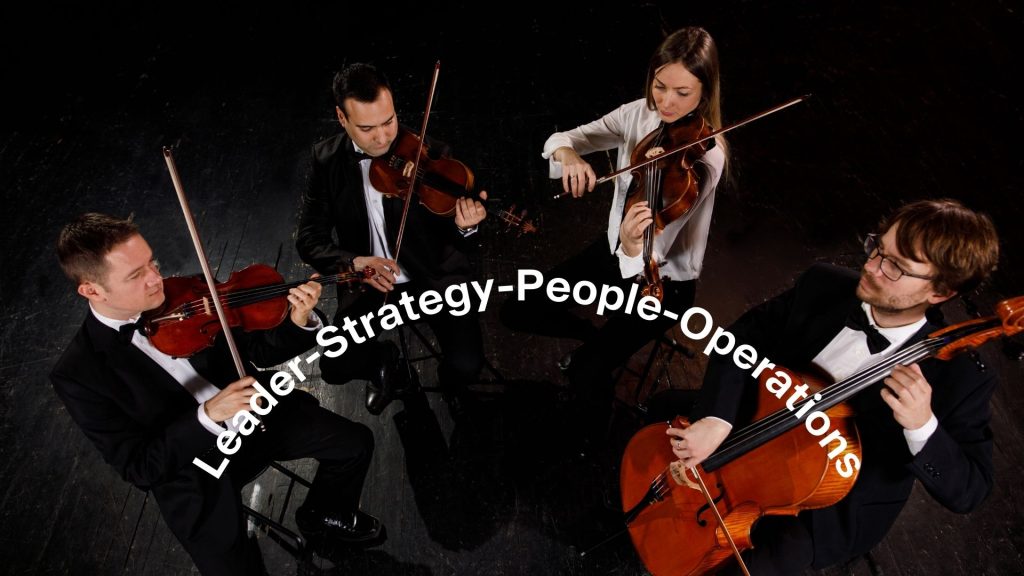As supply chain professionals, we constantly seek proven frameworks that can elevate our operations from good to exceptional. Cem Kozlu’s insights in “Liderin Takım Çantası” (Toolbox of the Leader) offer a compelling perspective through Muhtar Kent’s leadership approach: the Leader-Strategy-People-Operations quartet. I find this framework particularly resonant for our field.
Understanding the Quartet
Muhtar Kent’s approach recognizes that supply chain excellence isn’t built on operational efficiency alone. It requires a holistic integration of four critical elements: visionary leadership, strategic clarity, empowered people, and flawless execution. Each element is interdependent, creating a synergistic effect that transforms ordinary supply chains into competitive advantages.
Leader: The North Star of Supply Chain Transformation
In supply chain management, leadership transcends traditional hierarchical authority. The supply chain leader must be the chief storyteller, painting a vision of how integrated logistics, procurement, and distribution create customer value. This means:
Setting the Tone for Collaboration: Modern supply chains are ecosystems involving suppliers, manufacturers, distributors, and customers. A leader must foster a culture where internal teams and external partners see themselves as part of a unified value-creation network.
Embracing Digital Transformation: Today’s supply chain leaders must champion the digital acumen regardless of the technologies like AI, IoT and blockchain. Leadership here means being comfortable with uncertainty while guiding teams through technological evolution.
Risk Management Philosophy: Supply chain leaders must instill a proactive risk mindset throughout the organization. This isn’t about avoiding all risks, but about building resilient systems that can adapt and recover quickly from disruptions.
Strategy: Beyond Cost Optimization
The strategic element of Kent’s quartet challenges us to think beyond traditional supply chain metrics. While cost reduction remains important, strategic supply chain thinking encompasses:
Customer-Centric Design: Strategy should start with understanding how supply chain performance impacts customer experience. Fast delivery means nothing if quality suffers, and low costs are irrelevant if availability is inconsistent.
Sustainability Integration: Modern supply chain strategy must address environmental and social responsibilities. This isn’t just about compliance—it’s about recognizing that sustainable practices often drive innovation and long-term cost advantages.
Agility vs. Efficiency Balance: The strategic leader must determine when to optimize for efficiency and when to prioritize flexibility. This requires understanding market dynamics, customer expectations, and competitive positioning.
People: The Heart of Supply Chain Excellence
Technology enables supply chains, but people optimize them. The people component of Kent’s framework is particularly crucial in our field:
Cross-Functional Collaboration: Supply chain excellence requires breaking down silos between procurement, logistics, quality, and planning teams. People must be developed to think systemically, understanding how their decisions impact the entire value stream.
Supplier Relationship Management: Our people must be skilled not just in negotiation, but in partnership development. The best supply chain professionals build relationships that create mutual value and drive continuous improvement.
Data Literacy: Every supply chain professional must be comfortable with data analysis, from demand planners interpreting market signals to logistics coordinators optimizing route efficiency. This requires continuous learning and development investment.
Change Management Capabilities: Supply chains are constantly evolving. Our people need skills to implement new processes, adopt new technologies, and adapt to market changes without losing operational stability.
Operations: Where Strategy Meets Reality
The operations component brings everything together through disciplined execution:
Process Standardization: While flexibility is important, operational excellence requires standardized processes that ensure consistency and quality. This includes everything from supplier onboarding procedures to demand planning protocols.
Continuous Improvement Culture: Operations must embed improvement thinking into daily activities. This means creating systems where frontline workers can identify inefficiencies and contribute to solutions.
Performance Management Systems: Robust operations require clear metrics, regular reviews, and rapid response to performance gaps. This includes both internal metrics and supplier performance management.
Technology Integration: Operations must seamlessly integrate various systems—ERP, WMS, TMS, and supplier portals—to create smooth information and material flows.
Implementing the Quartet in Supply Chain Excellence

Phase 1: Leadership Foundation Start by establishing clear vision and values around supply chain excellence. This includes defining what “excellence” means for your organization and communicating how supply chain performance supports business objectives.
Phase 2: Strategic Alignment Develop supply chain strategies that directly support business strategy. This requires understanding customer needs, competitive positioning, and market dynamics. Create metrics that balance efficiency, effectiveness, and resilience.
Phase 3: People Development Invest in developing supply chain talent through cross-functional experiences, continuous learning programs, and leadership development. Build teams that can think strategically while executing operationally.
Phase 4: Operational Excellence Implement robust processes, systems, and continuous improvement programs. Focus on creating operations that are both efficient and adaptable.
The Synergistic Effect
The power of Kent’s quartet lies in its integration. A supply chain leader who focuses only on operations may achieve short-term efficiency gains but miss strategic opportunities. A strategically-minded leader who neglects people development may create brilliant plans that fail in execution. The quartet ensures balanced excellence.

Measuring Success
Success in applying this framework requires metrics that span all four elements:
- Leadership metrics: Employee engagement, change readiness, vision alignment
- Strategy metrics: Customer satisfaction, competitive positioning, innovation pipeline
- People metrics: Capability development, retention, collaboration effectiveness
- Operations metrics: Cost, quality, delivery, flexibility
The Muhtar Kent quartet offers supply chain leaders a comprehensive framework for building excellence that endures. By integrating leadership, strategy, people, and operations, we create supply chains that don’t just move products efficiently. They create sustainable competitive advantages that drive business success.
In our rapidly evolving business environment, this holistic approach isn’t just beneficial. It’s essential for supply chain leaders who want to build organizations that thrive in uncertainty while delivering consistent value to all stakeholders.
